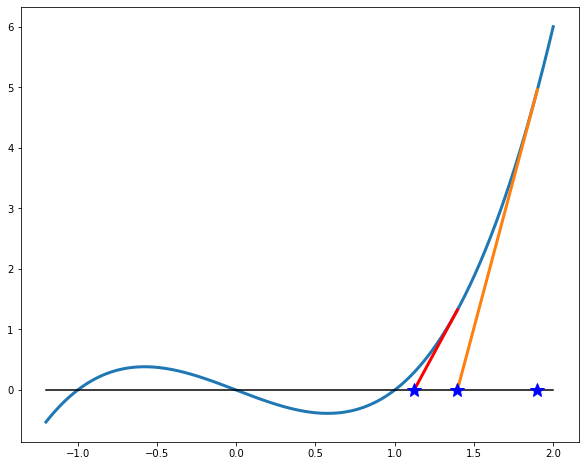Section 9.1 Newton's method
The idea of Newton's method is geometrically natural. We want to solve \(f(x) = 0\) but since \(f\) may be complicated, we replace it by its linear approximation (tangent line at a certain point). The resulting linear equation is easy to solve. Of course, its solution is probably not a solution of the original equation, but perhaps it is close to it. The process repeats, using the previously found solution as a new point at which to draw a tangent line. A static image of this process is below. Interactive visualization is also available.

Formally, the linear approximation to \(f\) at a point \(x\) is \(f(x+h) \approx f(x) + f'(x)h\text{.}\) Equating the right hand side to 0 we find \(h = -f(x)/f'(x)\) which means that the point where the tangent line at \(x\) meets the line \(y=0\) is \(x + h = x - f(x)/f'(x)\text{.}\) Therefore, we can express Newton's method as iteration of the function
Note that any point where \(f(x) = 0\) and \(f'(x)\ne 0\) is a fixed point of \(g\text{.}\) In fact, it is a super-attracting point of \(g\) because
which is zero when \(f(x) = 0\text{.}\)
Example 9.1.2. Find and simplify the function \(g\) of Newton's method.
Given \(f(x) = x^3 - x\text{,}\) find and simplify the function \(g(x) = x - f(x)/f'(x)\text{.}\)
Bringing \(g\) to common denominator often helps:
Once we have the function \(g\text{,}\) the rest of the process is the same as in Chapter 8, in particular in Example 8.2.1. Changing the first two lines of that program to
g = @(x) 2*x^3/(3*x^2-1); x0 = 0.6;
we get “Found x = 1 after 11 steps”. If the starting point is different, the process may converge to a different root of the equation \(x^3-x = 0\text{.}\) For example with x0 = 0.57 we get “Found x = -1 after 14 steps”. A small change of initial condition produced a rather different solution; we went from finding x = 1 to finding x = -1. The pattern of what starting points produce which solution can be very complicated: see the illustrations on Wikipedia page Newton fractal.